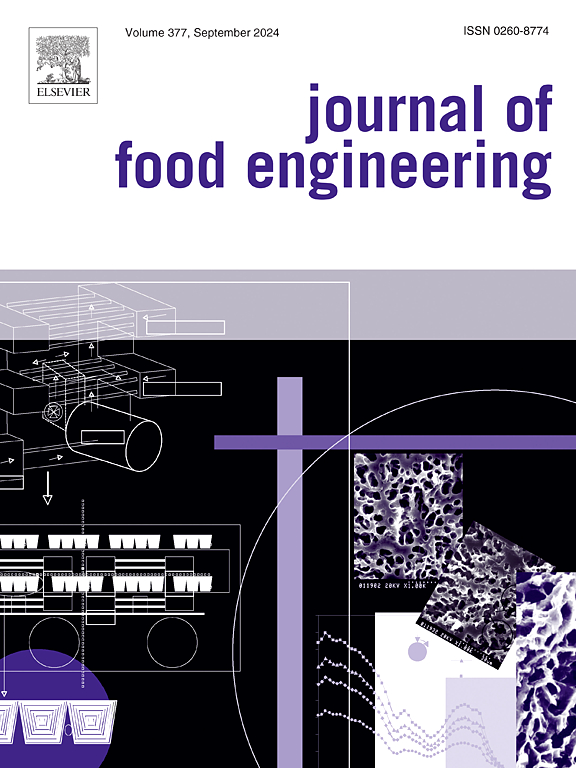Machine learning approach to inline monitoring of apple puree consistency through process data and fruit characteristics
IF 5.8
2区 农林科学
Q1 ENGINEERING, CHEMICAL
引用次数: 0
Abstract
Consistency is a key attribute for apple purée producers, since it affects the product quality and acceptability, and can be used to regulate the process settings. This study aims to build a statistical model to predict puree consistency using data collected from an industrial production line. The dataset includes 14 variables across 524 samples, comprising process parameters (e.g., pump performance, temperature) and characteristics of the apples. Three predictive models were developed incrementally. Model 1 relied on the mechanical energy conservation law to establish a relationship between a measured pressure drop and the consistency. In this study, we quantify consistency using the Bostwick flow distance, a widely adopted practical proxy for apparent viscosity in the food industry. Model 2 incorporated the machinery-related parameters, and Model 3 further integrated the characteristics of the apples to account for raw material variability. For models training and validation, generalized linear models (GLM), gradient boosting machines (GBM), and deep learning (DL) architectures were compared. The effect of the different input variables on the predictive performance was also assessed. In all models, pressure difference emerged as the most influential variable. Model 3, particularly with GBM, resulted in the highest predictive accuracy (R2 = 0.78; MAPE = 9.2 %), demonstrating the importance of incorporating ripening information of the apples in the model. The model outperforms traditional laboratory-based viscosity measurements, which typically have greater variability. The model considers the interactions between processing conditions and raw material properties that influence puree rheology, enabling a real-time inline consistency monitoring of apple puree in industrial settings, offering manufacturers operational benefits. These include the potential for reducing manual testing time and decreasing production costs through minimized batch rejections, and the ability to implement timely process adjustments. These advantages collectively contribute to reduced product waste, enhanced quality control, and improved economic outcomes in commercial apple puree production.
通过过程数据和水果特性在线监测苹果泥一致性的机器学习方法
一致性是苹果产品生产者的关键属性,因为它影响产品质量和可接受性,并可用于调节过程设置。本研究的目的是建立一个统计模型来预测果泥的一致性,使用从一条工业生产线收集的数据。该数据集包括524个样本中的14个变量,包括工艺参数(例如,泵性能,温度)和苹果的特征。三个预测模型是逐步建立的。模型1依靠力学能量守恒定律建立了测量压降与稠度之间的关系。在本研究中,我们使用Bostwick流动距离来量化一致性,这是食品工业中广泛采用的表观粘度的实用代理。模型2纳入了与机械相关的参数,模型3进一步整合了苹果的特性,以解释原材料的可变性。对于模型训练和验证,比较了广义线性模型(GLM)、梯度增强机(GBM)和深度学习(DL)架构。还评估了不同输入变量对预测性能的影响。在所有模型中,压差都是影响最大的变量。模型3的预测准确率最高(R2 = 0.78;MAPE = 9.2%),表明在模型中纳入苹果成熟信息的重要性。该模型优于传统的基于实验室的粘度测量,后者通常具有更大的可变性。该模型考虑了影响果泥流变性的加工条件和原材料特性之间的相互作用,能够在工业环境中实时在线监测苹果果泥的一致性,为制造商提供运营效益。其中包括减少人工测试时间和通过最小化批次拒收来降低生产成本的潜力,以及实施及时工艺调整的能力。这些优点共同有助于减少产品浪费,加强质量控制,提高商业苹果泥生产的经济效益。
本文章由计算机程序翻译,如有差异,请以英文原文为准。
求助全文
约1分钟内获得全文
求助全文
来源期刊

Journal of Food Engineering
工程技术-工程:化工
CiteScore
11.80
自引率
5.50%
发文量
275
审稿时长
24 days
期刊介绍:
The journal publishes original research and review papers on any subject at the interface between food and engineering, particularly those of relevance to industry, including:
Engineering properties of foods, food physics and physical chemistry; processing, measurement, control, packaging, storage and distribution; engineering aspects of the design and production of novel foods and of food service and catering; design and operation of food processes, plant and equipment; economics of food engineering, including the economics of alternative processes.
Accounts of food engineering achievements are of particular value.
 求助内容:
求助内容: 应助结果提醒方式:
应助结果提醒方式:


